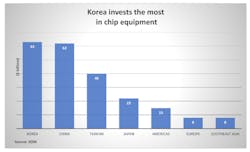Semiconductor manufacturers will increase spending on new fab equipment by 14% this year and another 7% in 2019, bringing investment in fab equipment to a record high, according to trade association SEMI.
Spending on fab equipment will rise to $62.8 billion in 2018 and to a record $67.5 billion in 2019, the association said. The spending will help boost production capacity for DRAMs, NAND, microprocessors, power management ICs, analog chips, and other semiconductors.
Aggressive spending on semiconductor equipment will continue beyond 2022 as more new fabs come online. Seventy-eight new fabs were scheduled to come online between 2017 and 2020, according to SEMI. Those new fabs will eventually require about $220 billion of new fab equipment. About 50% of the $220 billion will be spent from 2017 and 2020 while less than 10% was used to purchase chipmaking equipment in 2017 and 2018. About 40% of the $220 billion total will be spent on equipment and 2019 and 2020, according to SEMI.
Christian G. Dieseldorff, senior principal analyst for SEMI, said about 60% of the spending will be for 300 mm wafer and the rest for 200 mm and lower. “About half of the equipment is leading edge for logic and memory,” he said.
Dieseldorff added the spending on new equipment “will increase capacity, especially for 300 mm, memory, foundry/logic, LEDs, optoelectronics, and power semiconductors.”
Korean memory IC manufacturers will buy about $63 billion in equipment through 2020, while Chinese chip companies will invest about $62 billion during the time period, said SEMI. Taiwanese companies will spend $40 million; Japan, $22 billion; the Americas, $15 billion; in Europe and Southeast Asia, $8 billion each, according to the association.
Boost in Supply
While chipmakers are investing in new equipment to boost capacity, it may take several years for semiconductor supply to increase significantly because equipping a new fab takes one or two years depending on the fab size, product type, and region. Len Jelinek, vice president and chief analyst, technology, media, & telecom for researcher IHS Markit, said that the investment being made in new equipment between now and 2022 will result in semiconductor production capacity increasing about 10-12%.
He noted that the bulk of investment is being made by big semiconductor foundries such as TSMC, GlobalFoundries, UMC, and SMIC, and by memory IC manufacturers Samsung, SK Hynix, and Micron.
Jelinek said those companies have invested heavily in new chipmaking equipment, but their spending likely won’t be as aggressive in the next several years, especially with memory chipmakers. He added that DRAM and NAND flash memory manufacturers “don’t want to see a massive oversupply of wafers that cause average selling prices to crater,” so the investment in new equipment won’t be as robust after 2019.
“Their view of the world is they probably need to take a little pause” in expenditures for equipment, said Jelinek. He noted while foundries and memory IC manufacturers have made the most investments in equipment to increase capacity, integrated device manufacturers—including power management IC and analog chipmakers—are also investing more in new equipment.
Jelinek said companies such as Infineon, STMicroelectronics, and ON Semiconductor are seeing strong demand for power management ICs and other semiconductors, especially from automotive customers.
Until recently, “no one (non-memory IC companies) had been aggressively growing capacity in those areas, and what we’re finding out is automotive has dramatically impacted the power management companies,” said Jelinek. Demand for power management chips and other semiconductors from automotive systems suppliers has been strong as more electronics systems are designed into vehicles.
More Investment
As a result, a number of chipmakers have announced plans to build new fabs or purchase new equipment and upgrade existing ones. For instance, Infineon has announced it will construct a new 300 mm fab in Austria that will make power semiconductors, and Alpha and Omega Semiconductor is building a facility in China.
ST is forecasting it will make $1 billion in capital expenditures, and Infineon will spend $1.2 million—much of which will be for semiconductor equipment, said Jelinek. “Those kinds of investments we have not seen from IDMs for years,” he concluded. “You would have to go back to 2010 to see $1 billion investment s by non-memory companies.”










